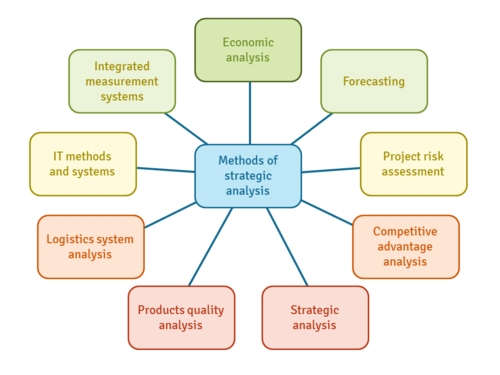Strategic analysis methods: Difference between revisions
(The LinkTitles extension automatically added links to existing pages (https://github.com/bovender/LinkTitles).) |
mNo edit summary |
||
| Line 25: | Line 25: | ||
Attention should be paid to the importance of company's principal activity for [[strategic management]]. The objective of the Management [[Board]], the mission and [[strategic objectives]], are translated into on the daily "operational" activities of all employees. Strategic management can not be "separated" for the purposes of research analysis and [[evaluation]] of [[operational management]]. | Attention should be paid to the importance of company's principal activity for [[strategic management]]. The objective of the Management [[Board]], the mission and [[strategic objectives]], are translated into on the daily "operational" activities of all employees. Strategic management can not be "separated" for the purposes of research analysis and [[evaluation]] of [[operational management]]. | ||
[[File:methods_of_strategic_analysis.png|500px|Fig.1. Strategic analysis methods groups]] | |||
Fig.1. Strategic analysis methods groups | |||
==List of methods== | ==List of methods== | ||
Revision as of 08:21, 4 September 2020
| Strategic analysis methods |
|---|
| See also |
In its core business and in the company's functional areas, managers use a variety of methods described in the literature and disseminated by scientific-research centers and other institutions. These methods were developed by practitioners and theorists in various fields of management. For the purposes of the presentation following methods were extracted:
- methods of economic analysis,
- forecasting methods
- methods of projects risk assessment
- methods of analysis of competitive advantage
- strategic analysis methods
- methods of product quality analysis,
- logistics system analysis methods,
- IT methods and systems.
Attention should be paid to the importance of company's principal activity for strategic management. The objective of the Management Board, the mission and strategic objectives, are translated into on the daily "operational" activities of all employees. Strategic management can not be "separated" for the purposes of research analysis and evaluation of operational management.
Fig.1. Strategic analysis methods groups
List of methods
Summary of the specific methods and techniques used within the groups listed above is shown in the following table. It should be noted that the method does not only relate to strategic management. Only two groups of methods may be classified as methods of strategic management par excellence (these are: methods of strategic analysis and competitive analysis). However, despite the loose connection with strategic management, these methods may be also applied in this area significantly expanding the scope of the analysis and the complexity of the results.
| Group | Description | Specific methods and techniques |
|---|---|---|
| Methods of economic analysis |
They concern fundamental analysis of economic values, such as revenues, costs, profits, expressed in monetary units, as well as their transformations in the form of indicators, measurement of dynamic, methods of forecasting and evaluation of investment projects. A common characteristic of these methods is to manipulate the data that is relatively easily available within the company. |
|
| Forecasting methods | They rely on the determination of the accuracy of specific economic variable used in the framework of strategic intelligence at the time. |
|
| Methods for assessing the risk of projects | Within this group we can specify the methods used in assessing the level of risk of an investment in the company |
|
| Methods for the analysis of competitive advantages of the company | These methods constitute an important tool for determination of lines of action and decision making. |
|
| Strategic analysis methods |
These are the methods of strategic analysis par-excellence. They include a wide set of methods for the analysis of sector and portfolio of company and its environment. |
|
| Methods for the analysis of the quality of products | Methods for the analysis of the quality of products are closely related to operating activities, because from there they derive the data, and their results are used directly in the production. Some of these methods are not only diagnostic, but also has the forecast element |
|
| Methods for the analysis of logistics system | Methods are used in analysis of enterprise logistics system, their goal is to improve it. |
|
| IT methods and systems | Associated with the use of information technology and tools for data processing. |
|
| Integrated measurement systems | A group of methods which aim is to provide a comprehensive look at the issues of the company in all the key areas of its activities. |
|
Source: own elaboration
References
- Bakos, J. Y. (1991). A strategic analysis of electronic marketplaces. MIS quarterly, 295-310.
- Fleisher, C. S., & Bensoussan, B. E. (2003). Strategic and competitive analysis: methods and techniques for analyzing business competition (p. 457). Upper Saddle River, NJ: Prentice Hall.
- Postma, T. J., & Liebl, F. (2005). How to improve scenario analysis as a strategic management tool?. Technological Forecasting and Social Change, 72(2), 161-173.
Author: Krzysztof Wozniak
